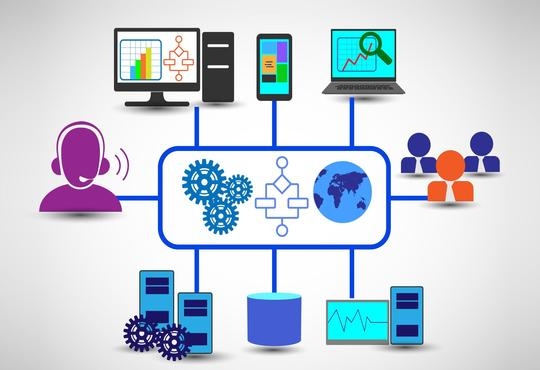
CIOTechOutlook >> Magazine >> December - 2013 issue
BYOD and Beyond
By
 BlackBerry India, headquartered in Gurgaon, Haryana is the Indian subsidiary of blackberry limited (NASDAQ:BBRY). The company is a provider of handheld telecommunication and wireless devices and services. The company has a market cap of $3.2 Billion.
BlackBerry India, headquartered in Gurgaon, Haryana is the Indian subsidiary of blackberry limited (NASDAQ:BBRY). The company is a provider of handheld telecommunication and wireless devices and services. The company has a market cap of $3.2 Billion.Till about a decade back, mobile management solutions were fairly basic and fragmented with focus on devices rather than services. Mobile device management, security and various other services were provided by different vendors, adding to a complex system. Application management was an unknown concept and security features limited to basic levels. That said, BYOD is here to stay and is a very real IT challenge that CIOs are hard pressed to tackle given the plethora of mobile devices, operating systems and applications that are coming into the fold of the enterprise network.
There is a critical need to make the right choice regarding how to manage mobility and BYOD. Let us look at the common five challenges related to BYOD and how they can be addressed.
- Enabling users to securely accomplish work related tasks on personally owned devices:
With BYOD, a significant number of employees use personally owned devices to accomplish work-related tasks. It is a matter of great concern when corporate data co-mingles with personal data. For example, a productivity app may access the user's calendar. With the device being used for both personal and work tasks, it is not just the users data that is at risk, but the organization's too.
This issue can be handled by containerization and encryption. The term containerization is used for a range of technologies that can create separate secure workspaces on a mobile device. Personal and work spaces are kept separate including data and applications. The work environment is fully encrypted, managed and secured. BlackBerry Enterprise Service 10 comes with a feature called BlackBerry Balance that enables IT Managers to compartmentalize work and personal data on user's BlackBerry 10 smartphone. This feature is also available for other platforms currently like Android and iOS
- Accommodating a diverse inventory of mobile devices:
For organizations dealing with BYOD, the ability to manage and secure devices running on different operating systems is critical. With BYOD it is very important that users are allowed to perform work on the device of their choice. In any workplace, there is a clear need to accommodate a diverse inventory of mobile devices.
Most MDM solutions enable IT departments to manage multiple platforms. However, while evaluating MDM solutions, it is important to consider not only the platforms they support today, but those they may support in the future and in the most secured way.
- Effectively enforcing policies for both personally owned and corporate-provisioned devices, and enforcing different policies for different user types:
The ability to implement policies across all devices and platforms is an important part of the MDM puzzle. That said, MDM needs to be treated like an extension of your enterprise architecture where access controls are managed even on the mobile device. A user segmentation is critical.
However, the number of organizations with policies in place that manage mobile risks posed by personally owned devices is very low.
The answer to this policy enforcement can be routed back to containerization. Separating the corporate workspace from the personal workspace on mobile devices reduces the number of policies required to effectively manage mobile risks. Furthermore, the MDM solution should provide a centralized console through which IT administration can manage policies across a diverse range of devices, regardless of whether they are personally owned or corporate provisioned.
- Minimizing the administrative burden of BYOD on staff:
BYOD may increase user productivity, but it can also have adverse effect on the IT department. Instead of managing a standardized range of devices, IT must now manage and secure multiple platforms of which they have limited visibility and control. This has created an administrative burden for IT with the need for increased resources to ensure enterprise level security.
An efficient MDM solution that enables IT to manage the work and personal areas on both personally owned and corporate devices, and security at the server level, can ease the administrative burden that accompanies BYOD. The solution should provide an integrated view of the entire mobile landscape through an intuitive administrative console. This console can help the administration to manage all applications, devices, users and security services. A simplified EMM (Enterprise Mobility Management) solution, will allow enterprises to reap the business productivity benefits of BYOD without negatively impacting IT's productivity.
- Supporting all aspects of the mobility landscape:
Aside from grappling with a diverse fleet of devices, IT managers need to support applications and platforms as well. An MDM solution needs to be considered holistically today. Managing a device is not the only consideration anymore. Services provisioned on that device, applications deployed and their secured functioning is critical as well. MDM today has evolved into this sophisticated system that few providers are able to offer.
Needless to say there is still need for continued efforts and investments to create a scalable, secure and manageable mobility infrastructure to support BYOD, and capitalize on the merits of this pervasive and growing trend.
CXO Insights
Phykon: Thought Leadership to Address Contact...
By CIOReview Team
Virtualization: A Smooth Transition to Cloud...
By Murali Ramalingam, Country Manager, India, Ixia
Virtualization-'Real' need in 5G networks and IoT




